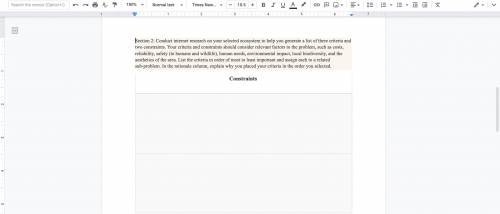
Biology, 30.11.2020 20:50 dleflore80
Section 2: Conduct internet research on your selected ecosystem to help you generate a list of three criteria and two constraints. Your criteria and constraints should consider relevant factors to the problem, such as costs, reliability, safety (to humans and wildlife), human needs, environmental impact, local biodiversity, and the aesthetics of the area. List the criteria in order of most to least important and assign each to a related sub-problem. In the rationale column, explain why you placed your criteria in the order you selected.


Answers: 1


Other questions on the subject: Biology


Biology, 22.06.2019 19:00, admierewebb
Penicillin is hydrolyzed and thereby rendered inactive by penicillinase (also known as β-lactamase), an enzyme present in some resistant bacteria. the mass of this enzyme in staphylococcus aureus is 29.6 kd. the amount of penicillin hydrolyzed in 1 minute in a 10-ml solution containing 10-9 g of purified penicillinase was measured as a function of the concentration of penicillin. assume that the concentration of penicillin does not change appreciably during the assay. penicillin(μm) amount hydrolyzed(nmol) 1 0.11 3 0.25 5 0.34 10 0.45 30 0.58 50 0.61 (a) plot v0 versus [s] and 1/v0 versus 1/[s] for these data. does penicillinase appear to obey michaelis-menten kinetics? if so, what is the value of km? (b) what is the value of vmax? (c) what is the turnover number of penicillinase under these experimental conditions? assume one active site per enzyme molecule.
Answers: 2

Biology, 22.06.2019 21:00, lorydiane
What would happen if a plant could carry out photosynthesis, but not respiration? question 1 options: it would have no food. it would have too much water. it would be unable to capture the energy in sunlight. it could make food but not break it down for energy.
Answers: 1

Biology, 22.06.2019 23:00, sanchezp0821
Waste water from industries and domestic sources can be treated by chlorination or ultraviolet radiation. there are pros and cons to using either chlorine or uv radiation to kill harmful microorganisms. what is one reason chlorination would be preferred over ultraviolet radiation? a) chlorine only eliminates visible impurities and is ineffective against microorganisms. b) chlorine not only kills bacteria but provides a residual effect on returning microorganisms. c) uv radiation can be used only to treat drinking water and is ineffective in treating waste water. d) ultraviolet radiation is more effective
Answers: 2
You know the right answer?
Section 2: Conduct internet research on your selected ecosystem to help you generate a list of three...
Questions in other subjects:

History, 06.01.2020 20:31


Social Studies, 06.01.2020 20:31


Mathematics, 06.01.2020 20:31



Mathematics, 06.01.2020 20:31




